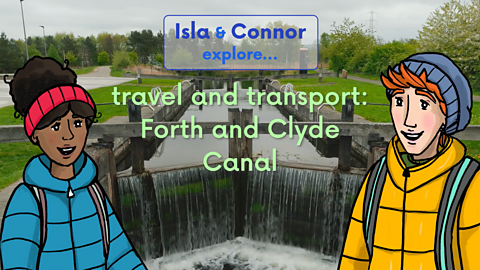Land use in the Highlands
The same area of land can be used by different groups of people for different purposes. It is best when people consider others, the wildlife and environment but this isn't always straightforward.
In this article you can learn about:
- different kinds of land use and issues that might arise
- responsible code for walkers and visitors to protected areas
- Victorian tourism in the Highlands and its legacy
This article is suitable for learning about People, Place and Environment topics in primary school.
Video - Land use in Glen Feshie
Join Isla and Connor on a walk through Glen Feshie, where they learn how different human activities impact each other and the landscape.
ISLA: I've wanted to walk through Glen Feshie for ages.
CONNOR: Oh no, the footpath, its gone!
Land can be eroded by ice, water, wind, and of course, people.
This footpath's been eroded by the River Feshie.
ISLA: The footpath keeps walkers following one route.
When we're in the countryside we should be aware of the environmental problems we might cause.
Just walking can cause soil erosion disturb wildlife, trample new plants, and cause pollution if you drop anything or leave wastebehind.
CONNOR: Let's be careful going off the path then.
Luckily, we can go around the landslip and join up with the footpath again.
Oh look! A red deer.
ISLA: Oh, aren't they beautiful, but the deer can be a bit of an issue here in the Highlands.
There have been red deer in Scotland for thousands of years.
But since Victorian times the number of deer has grown hugely.
That's because in the 19th century hunting deer for leisure became big business.
Numbers of deer were kept high to bring in more money.
But when there are lots of deer grazing, they can strip woodlands of young plants and damage the ecosystem and the landscape.
CONNOR: But what do deer numbers have to do with the footpaths?
ISLA: Deer can prevent trees growing and if there are fewer trees, paths are less sheltered from erosion.
CONNOR: But erosion is natural, isn't it?
ISLA: Yes, but human activity can make erosion more damaging.
Where there are trees their roots hold the soil together and trees and other plants soak up rainwater, so water and rivers don't run as fast or as suddenly.
Where people have cut down trees for timber or to clear farmland or where people have encouraged lots of deer, the ground is more exposed to the weather.
Heavy rain can wash the soil away and rivers can suddenly become bigger and faster and erode the land along their banks.
Even just wear and tear from lots of walkers can add to erosion.
That's why the footpath is here to stop people from damaging the landscape they've come to see.
CONNOR: So the different ways people use the land can have long lasting effects.
Here in Glen Feshie the number of deer has been reduced, so that trees and other plants have a better chance to grow.
Look there, the new trees look like they're doing all right.
ISLA: That's because of a big rewilding project here to bring back the trees.
Rewilding is a conservation effort to restore and protect natural processes and wild areas.
CONNOR: So everyone is happy?
ISLA: It's not that simple.
Rewilding might be good for native species and for walkers, but reducing deer numbers might mean less money for sporting estates and rewilding land means it can't be used for farming or timber, so that might mean less money and jobs for the local economy.
People have lots of different ideas for how to use the land and often these ideas are in conflict.
There is no one answer that will work for everyone.
The Ruigh Aiteachain Bothy.
CONNOR: Bothies are usually old cottages or huts kept for people travelling through sparsely populated areas who might need to stop and rest.
You can warm up by the fire and cook food, even spend the night as long as you follow the bothy code:
Respect other users
Respect the bothy
Respect the surroundings
Respect the agreement with the estate and respect the restriction on numbers.
In Scotland, everyone has a right to roam by law which is great, but just a walk through the hillscan have a bigger effect on the land than we realise.
ISLA: Right.
Be mindful of your impact.
Use a map.
Stick to the footpaths.
Respect other land users.
Take your rubbish home.
And always pack a spare pair of socks.
Where is Glen Feshie?
Glen Feshie is a sporting estate on the edge of the Cairngorms National Park.
It attracts visitors because of its natural beauty, and outdoor country sports like shooting and fishing. Visitors can provide income, as they bring money with them to spend on their travels, but there can be issues when different groups of people use the same area of land.
Here are some examples of what visitors to an area like Glen Feshie might encounter.
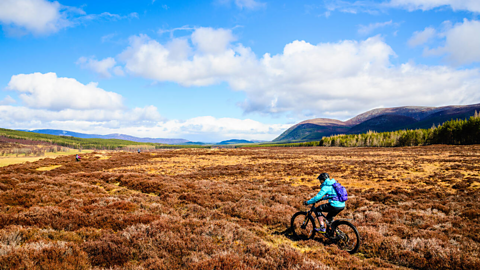
Image caption, Exploring the landscape
Walking, hiking and cycling are fun pursuits in rural areas. Visitors are valuable to the local area as they bring money, but they can also have an impact on the landscape. Footpaths and trails can wear away with use from walkers and cyclists, and surrounding plant life can be affected. (Jon Sparks/Alamy Stock Photo)
Image caption, Bothies
Bothies are small huts where hillwalkers and visitors can stop for shelter, or even spend a night. It's important that anyone visiting a bothy follows the Bothy Code - respect other users, respect the bothy, respect the surroundings, respect the agreement with the estate and respect the restriction on numbers (usually groups of no more than six people). (GFC Collection / Alamy Stock Photo)
Image caption, Country sports
Sporting estates, like the one at Glen Feshie, attract people who enjoy country sports such as angling (fishing with a rod and line), grouse shooting and deer stalking (hunting and shooting them). Some people support these sports because they can bring visitors, money and jobs to the area. Other people object and think these activities are cruel. (MediaWorldImages/Alamy Stock Photo)
Image caption, Wildlife watching
As well as walkers and cyclists who come to enjoy the landscape, wildlife and nature lovers also visit areas like Glen Feshie, sometimes with binoculars or cameras to spot their favourite birds and animals. As many rare species can be found in the area, this is an ideal chance for keen visitors to try and spot eagles, wildcats, ptarmigan, pine martens and other animals in their natural habitat. (John Bentley/Alamy Stock Photo)
1 of 4
What is the right to roam?
In Scotland, people have the 'right to roam'. This means they are free to explore the landscape without needing permission from the owner of the land, as long as they behave responsibly. The Scottish Outdoor Access Code lays out the three simple principles for being responsible when enjoying the outdoors:
- Respect the interests of other people.
- Care for the environment.
- Take responsibility for your own actions.
Land managers must also follow these principles, to make sure people can enjoy the outdoors safely.
Victorians and visitors
The Highlands became a popular destination for tourists during the reign of Queen Victoria. The 'unspoilt' scenery that the tourists came to expect may have been nice for them to look at, but it was also evidence of the Highland Clearances where families were cleared from their homes to make way for sheep or deer.
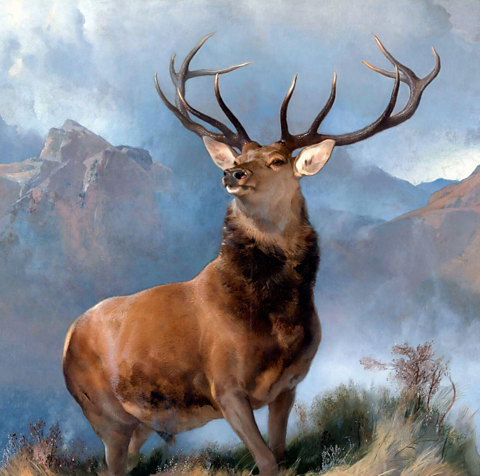
'Monarch of the Glen' is a famous painting by the artist Sir Edwin Landseer. It shows a red deer stag in an empty wilderness and is said the landscape is based on Glen Feshie.
The painting is associated with a romanticised view of the Highlands. This means that people who see the painting or visit the Highlands imagine that the landscape is a natural wilderness. In fact, most of the landscape of Scotland that we see today is the result of human action, including clearing forests, farming and tourism.
The painting shows the beauty of nature, without showing anything else about real life in the area.
This is one reason why clear instructions like the Outdoor Access Code are needed. It reminds visitors that this is a landscape where people live and work, and tells us how to be respectful of both the people and the landscape.

Wildlife and plant life
The conservationProtection of the natural environment. and management of wildlife is an important issue in places like Glen Feshie. The area is a habitatThe natural home of a plant or an animal. for over 5000 birds and animals, around 1,000 of which are described as 'nationally rare' or 'scarce'.
When did Glen Feshie rewilding start?
In the early 19th Century, deer stalking in Glen Feshie became an important leisure activity at sporting estates. Numbers of deer were kept artificially high, to attract visitors who would then come to stalk and shoot the deer.
However, the numbers of deer grazing prevented young plants from developing, which stopped the forest from growing. In 2004, a large number of deer were killed in a cull. This reduced the number of deer to allow these plants to regrow.
This process of allowing native plants to regrow, or deliberately replanting native plants, is called rewildingActivities undertaken to restore natural habitats to their original state..
There are different opinions about rewilding:
- Some people want to rewild areas like Glen Feshie to provide a safe habitat for native plants and animals.
- It is argued that creating more forests and planting can help reduce carbon in the atmosphere and help limit climate change.
- Other people think that rewilding means that there will be less land for farming or that rewilded areas will be closed off to visitors, taking away their 'right to roam'.
- Some people are unhappy that deer are killed as part of this process.
The debate around how to best manage this important plant and wildlife habitat continues.
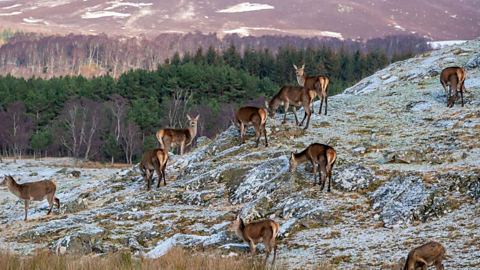
Image caption, Deer population
The numbers of deer in Glen Feshie were kept high for years to encourage visitors for both wildlife spotting and stalking. In recent years, the large cull of deer has allowed the native trees and plants to grow. There are still several deer species living in the glen. (Angus McComiskey/Alamy Stock Photo)
Image caption, Capercaillie
The capercaillie is one of the most endangered bird species in the UK. It is estimated that there are fewer than 1000 of them left in the wild. More than 80% of these live in the area of the Cairngorms National Park. (Tim Oliver/Alamy Stock Photo)
Image caption, Native forests
Glen Feshie is home to part of the ancient Caledonian Forest - a native pine forest. Native species such as the pine marten and capercaillie are found in pine forests and so, when the forest was allowed to regrow, this provided a larger area of thriving habitat for these birds and animals. Since the rewilding project began, juniper bushes and heathers are also growing here again. (Marieke Peche/Alamy Stock Photo)
1 of 3

Key words about land use
Sorry, something went wrongCheck your connection, refresh the page and try again. - when animals are killed to keep their numbers under control
Sorry, something went wrongCheck your connection, refresh the page and try again. - protection of a natural environment or species
Sorry, something went wrongCheck your connection, refresh the page and try again. a large area covered mainly by trees and bushes
Sorry, something went wrongCheck your connection, refresh the page and try again. - the process of allowing native plants to regrow in an area, sometimes through a cull of animals
Sorry, something went wrongCheck your connection, refresh the page and try again. - a country sport that involves closely following and shooting wild deer
Sorry, something went wrongCheck your connection, refresh the page and try again. - a large area of land, owned by one person or company. Many estates have a large house somewhere on the property
Test your knowledge
Quiz
Challenge

How can different groups share the same space?
Think of a shared space in your community - a park, a hall, or another place where people gather.
Can you think of three different groups of people who might use this place for different purposes? Think about what they want out of this space. How might this be different from other people?
Try to come up with a solution that means everyone can be happy using the space.
Four ways to give back to nature through rewilding
THE REGENERATORS
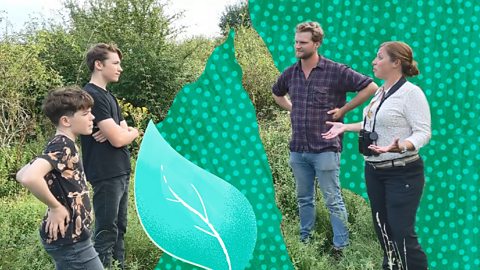
Holidays and leisure in Victorian Scotland
Learn more about how the Victorians made holidays popular.
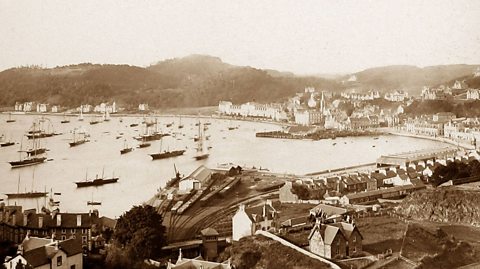
How do human beings affect the environment?
Learn more about the positive and negative effects humans can have on the world around them.

More on Landscapes
Find out more by working through a topic
- count4 of 25
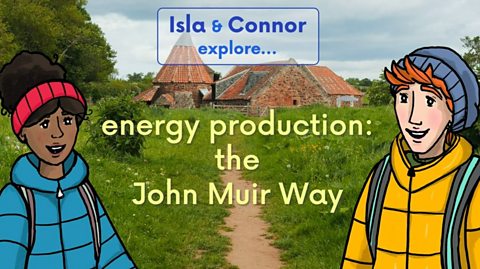
- count6 of 25
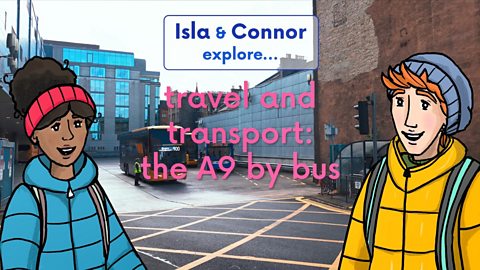
- count7 of 25
